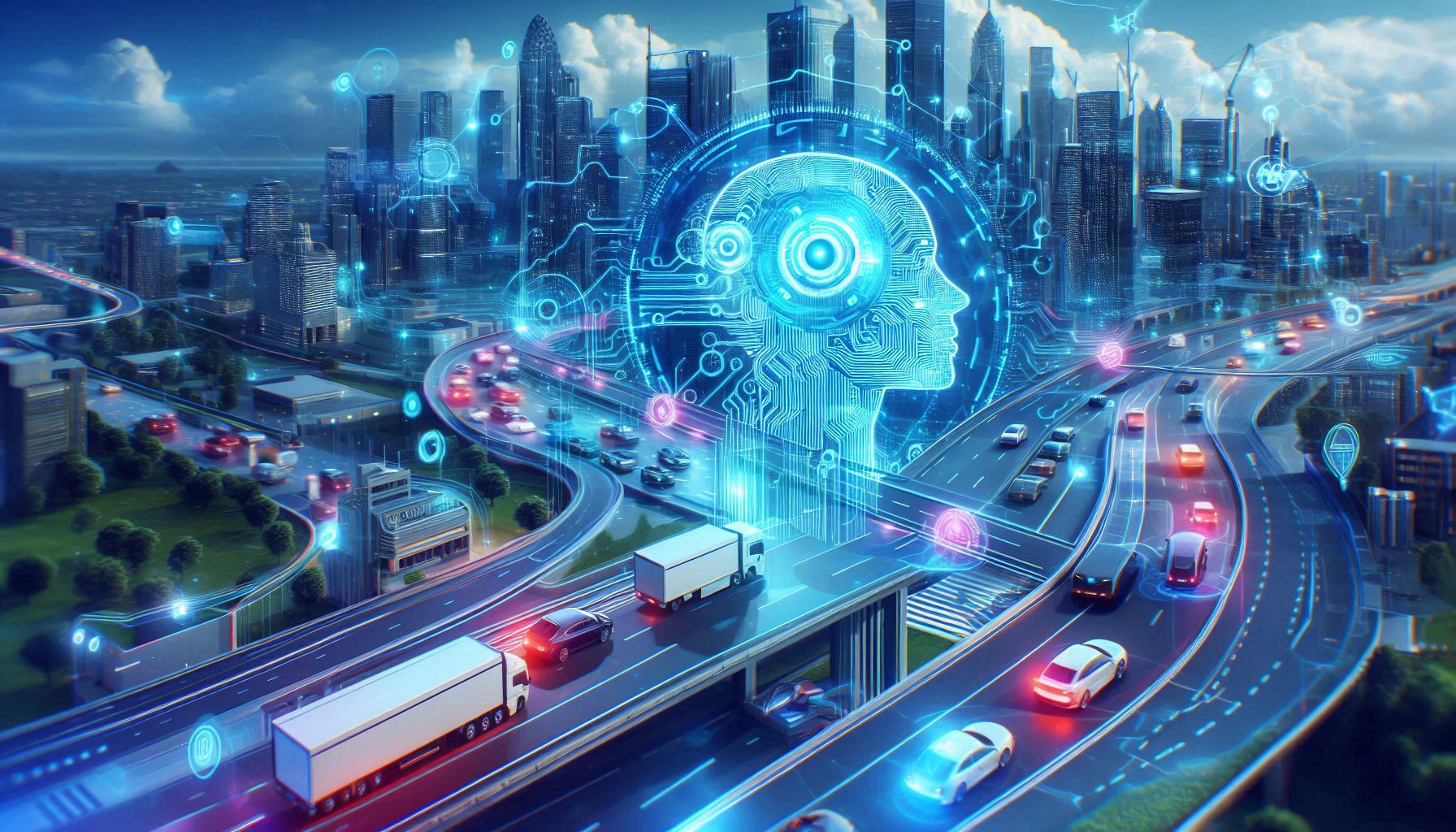The potential of artificial intelligence (AI) in transforming transportation
 AIperity
AIperity
As experts in the field of artificial intelligence with over a decade of experience, we at AIperity are excited to share our insights on the transformative power of AI in the transportation sector. This article will delve into the exciting possibilities and real-world applications of AI that are reshaping how we move and transport goods.
AI is not just a buzzword in transportation; it's a revolution in motion. From autonomous vehicles to smart traffic management systems, AI is paving the way for safer, more efficient, and sustainable transportation solutions. Whether you're a transportation industry professional, a tech enthusiast, or simply curious about the future of mobility, this article will provide you with valuable insights into the AI-driven future of transportation.
The Current State of AI in Transportation
The transportation industry is undergoing a profound transformation, largely driven by advancements in artificial intelligence. AI technologies are being integrated into various aspects of transportation, from vehicle design to traffic management and logistics.
One of the most visible applications of AI in transportation is the development of autonomous vehicles. Companies like Tesla, Waymo, and traditional automakers are investing heavily in self-driving technology, which relies heavily on AI algorithms for perception, decision-making, and control.
But AI's impact extends far beyond just cars. Let's explore some key areas where AI is making significant strides in transportation.
AI in Traffic Management and Urban Planning
Smart Traffic Systems
AI-powered traffic management systems are revolutionizing urban mobility. These systems use real-time data from various sources, including cameras, sensors, and GPS devices, to optimize traffic flow.
For example, adaptive traffic lights equipped with AI can adjust their timing based on current traffic conditions, reducing congestion and improving overall traffic flow. Cities like Pittsburgh have implemented such systems, resulting in significant reductions in travel time and emissions.
Predictive Maintenance for Infrastructure
AI algorithms can analyze data from sensors placed on bridges, roads, and railways to predict when maintenance is needed. This proactive approach helps prevent accidents and reduces downtime, ensuring safer and more reliable transportation networks.
AI in Logistics and Supply Chain Management
Route Optimization
AI algorithms can process vast amounts of data to determine the most efficient routes for delivery vehicles. This not only saves time and fuel but also reduces the carbon footprint of logistics operations.
Demand Forecasting
By analyzing historical data and current trends, AI can accurately predict demand for goods in different locations. This helps companies optimize their inventory and distribution strategies, reducing waste and improving efficiency.
The Rise of Autonomous Vehicles
Self-Driving Cars
Perhaps the most talked-about application of AI in transportation is self-driving cars. These vehicles use a combination of sensors, cameras, and AI algorithms to navigate roads safely without human intervention.
While fully autonomous vehicles are not yet widely available for consumer use, companies like Waymo are already operating self-driving taxi services in some cities.
Autonomous Trucks
The trucking industry is also embracing AI technology. Autonomous trucks have the potential to increase safety, reduce fuel consumption, and address the ongoing driver shortage in the industry.
Companies like TuSimple and Embark are already conducting long-haul tests with autonomous trucks, showcasing the viability of this technology.
AI in Public Transportation
Optimized Bus and Train Schedules
AI can analyze ridership patterns and other factors to optimize public transportation schedules, ensuring better service during peak hours and reducing unnecessary trips during off-peak times.
Predictive Maintenance for Vehicles
Similar to infrastructure maintenance, AI can predict when vehicles need maintenance, reducing breakdowns and improving the reliability of public transportation services.
Challenges and Considerations
While the potential of AI in transportation is immense, there are several challenges that need to be addressed:
Safety and Reliability
Ensuring the safety and reliability of AI systems in transportation is paramount. Rigorous testing and validation processes are necessary before widespread adoption.
Ethical Considerations
The use of AI in transportation raises ethical questions, particularly in situations where AI systems must make split-second decisions that could affect human lives.
Job Displacement
The automation of certain transportation jobs may lead to displacement of workers. It's crucial to consider retraining and transition programs for affected workers.
Data Privacy and Security
With AI systems relying heavily on data, ensuring the privacy and security of this information is a significant concern that needs to be addressed.
The Future of AI in Transportation
As AI technology continues to advance, we can expect to see even more innovative applications in transportation:
Flying Taxis: Companies like Uber and Joby Aviation are working on AI-powered flying taxis for urban air mobility.
Hyperloop Systems: AI will play a crucial role in managing and optimizing high-speed transportation systems like the Hyperloop.
Smart Cities: Integrated AI systems will manage entire city transportation networks, from traffic lights to parking spaces, creating more efficient and livable urban environments.
Conclusion
The potential of AI in transforming transportation is vast and exciting. From making our roads safer to optimizing logistics and creating new modes of transport, AI is set to revolutionize how we move people and goods.
As we continue to develop and implement these technologies, it's crucial to address the challenges and ethical considerations that come with them. By doing so, we can harness the full potential of AI to create a transportation system that is safer, more efficient, and more sustainable for everyone.
At AIperity, we're committed to staying at the forefront of these developments and helping businesses and organizations implement AI solutions in transportation. Visit our website at https://aiperity.com to learn more about our AI services and how we can help you navigate the future of transportation.
Frequently Asked Questions
How soon can we expect fully autonomous vehicles to be widely available?
While significant progress has been made, the widespread availability of fully autonomous vehicles (Level 5 autonomy) is still several years away. Factors such as technology refinement, regulatory frameworks, and public acceptance all play a role in the timeline. However, we're already seeing limited deployments of autonomous vehicles in controlled environments and specific use cases.
What impact will AI have on jobs in the transportation sector?
AI will likely lead to the automation of certain jobs in the transportation sector, particularly in areas like driving and logistics planning. However, it's also expected to create new job opportunities in areas such as AI system development, maintenance, and oversight. The key will be to manage this transition effectively, providing retraining opportunities for workers in affected roles.
How can small transportation companies start implementing AI in their operations?
Small transportation companies can start by implementing AI in areas that offer immediate benefits and have lower barriers to entry. This could include using AI-powered route optimization software, implementing predictive maintenance systems, or using AI for demand forecasting. Many of these solutions are available as software-as-a-service (SaaS) platforms, making them accessible to smaller businesses without requiring significant upfront investment.
We encourage you to follow AIperity for more insights and updates:
Website: https://aiperity.com
YouTube: https://youtube.com/@aiperity
Fanpage: https://www.facebook.com/profile.php?id=61561931647082
Twitter: https://x.com/AIperity
Instagram: https://www.instagram.com/aiperity/
Subscribe to my newsletter
Read articles from AIperity directly inside your inbox. Subscribe to the newsletter, and don't miss out.
Written by
